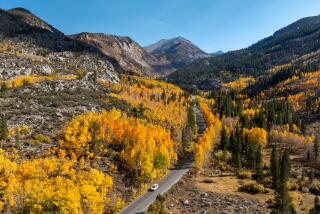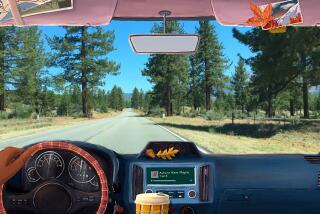Falling for Color
It’s hard to muster any sympathy for us Southern Californians, living as we do in one of the most charitable latitudes in the country for flowers and foliage of all sorts.
We turn green with envy in late fall, though, when places like New England are flush with fall colors. Yet there are plenty of colorful leaves in Orange County--if you know where to look.
Local botanists say the best places to see fall foliage here are the Silverado, Trabuco and Bell canyons, where deciduous trees--those that shed their leaves annually--produce colorful displays despite the mild climate.
“We don’t get the cold snaps here that chill the leaves quickly to expose the reds and yellows that they get up in the mountains or back East,” said Elisabeth Brown, biologist and president of Laguna Greenbelt, a local land-preservation organization in Laguna Beach.
“For years, we had a beautiful golden willow out in Laguna Canyon that put on quite a show,” she said, “but it was taken out for the toll road.”
The main factors that produce colorful foliage are day length and temperature, said Richard Evans, an Extension specialist at UC Davis. Even if temperatures don’t dip into the freezing zone, he said, days do get cooler and shorter--enough of a change to cause leaves to turn and fall.
As temperatures fall, a layer of cells forms across the leaf, cutting off its flow of nutrients. As the leaf uses up stored sugars and starches, its green coloring fades and the less-dominant pigments--reds, yellows and browns--become visible.
“You certainly get the yellows in Southern California, just not as much of the intense reds,” Evans said.
Local trees that put on a fall show are the silver-leaf, Japanese and big-leaf maples; and the ginkgo, which turns a bright yellow.
Other good prospects are the red-leafed liquidambar; the California black walnut and the box elder, which both turn shades of yellow; and the arroyo, Pacific and red willows, which also turn yellow but may morph into shades of orange.
Other Orange County possibilities for leaf watching are Caspers Wilderness Park on California 74 east of San Juan Capistrano; O’Neill Regional Park on Trabuco Canyon Road in Trabuco Canyon; Santiago Oaks Regional Park on Hewes Street in Orange; and Irvine Regional Park on Chapman Avenue east of Orange.
“If you look closely, there’s plenty to see,” said David Pryor, research ecologist for the Orange Coast District of California state parks. “In the nighttime, it’s getting into the 40s now. That’s enough of a temperature change to trigger the leaf drop.”
More to Read
Sign up for The Wild
We’ll help you find the best places to hike, bike and run, as well as the perfect silent spots for meditation and yoga.
You may occasionally receive promotional content from the Los Angeles Times.






